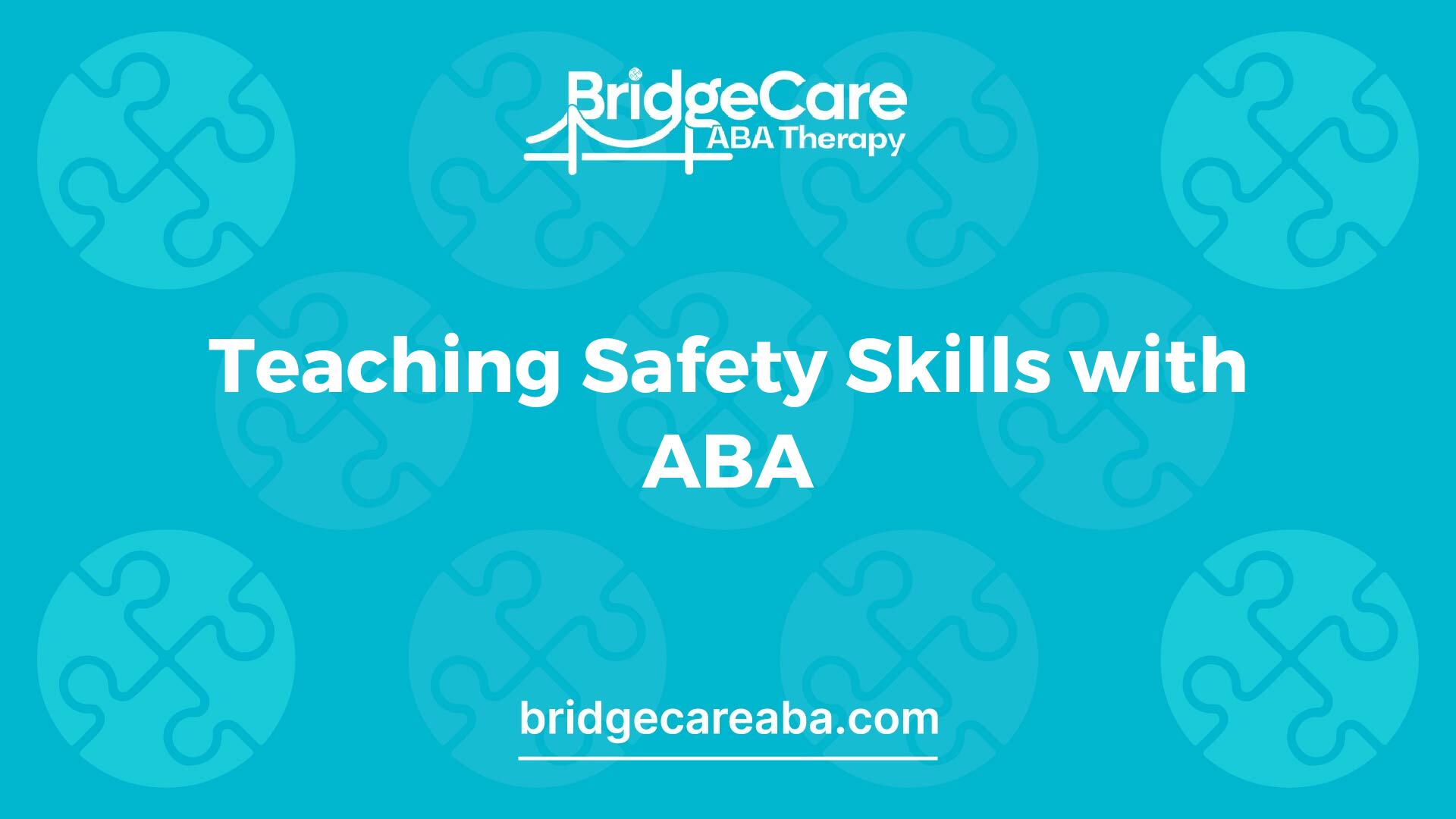Teaching Safety Skills with ABA
Discover effective strategies for teaching safety skills with ABA to empower individuals with autism!
Teaching Safety Skills with ABA
Discover effective strategies for teaching safety skills with ABA to empower individuals with autism!
Importance of Teaching Safety Skills
Benefits of Safety Skill Training
Teaching safety skills is crucial for individuals with autism. Safety skill training provides a foundation for independence and enhances overall well-being. The benefits of focusing on safety skills are numerous.

BenefitDescriptionIncreased IndependenceLearners gain the ability to navigate various situations confidently, reducing reliance on adults.Enhanced Social SkillsSafety training can improve a learner’s ability to interact with others and recognize safe interactions.Risk AwarenessIndividuals become more aware of potential dangers in their environment, such as stranger danger and traffic.Improved Emergency ResponseTraining can prepare learners for emergencies, teaching them how to seek help or use a phone effectively.
Evidence supports the effectiveness of teaching safety skills through structured programs, including Behavioral Skills Training (BST) and In Situ Training (IST). These methods have proven beneficial in addressing essential safety concepts, such as abduction prevention and recognizing safe individuals in the community.
A landmark study by O. Ivar Lovass, Ph.D., in 1987 demonstrated that children receiving intensive ABA therapy showed substantial improvement in their social skills, with approximately 47% becoming indistinguishable from their peers [1]. This highlights the importance of comprehensive training that includes safety awareness.
Moreover, teaching adolescents to use a cell phone can improve their safety and independent living skills. Skills include answering calls, following directions, and knowing how to call for help in emergencies [2].
Overall, investing in safety skill training not only contributes to immediate safety but also lays the groundwork for lifelong independence and confidence. Encouraging parents and caregivers to engage in these training methods is essential for fostering a safe environment for individuals with autism.
Key Areas of Safety Skills
When teaching safety skills through Applied Behavior Analysis (ABA), it is important to focus on three primary areas. These areas are designed to empower children, particularly those with autism, to navigate their environments safely and independently. The key areas include Stranger Danger Awareness, Street and Car Safety, and Fire Safety.
Stranger Danger Awareness
Stranger Danger Awareness is crucial for ensuring children understand how to identify safe and unsafe individuals. This awareness involves teaching children to recognize situations that may pose a risk, such as being approached by strangers in public spaces. Children learn to respond appropriately, such as walking away and seeking help from a trusted adult.
Key PointsDescriptionIdentification of Safe AdultsTeach children to recognize trusted adults (e.g., parents, teachers).Recognizing Unsafe SituationsDiscuss various scenarios where a stranger may approach them.Appropriate ResponsesEducate children on what to do if approached by a stranger (e.g., yelling for help, running towards a safe place).
Street and Car Safety
Street and Car Safety education helps children learn how to navigate public spaces safely. This includes understanding pedestrian rules, being aware of traffic signals, and practicing proper behaviors when near vehicles.
Key PointsDescriptionTraffic SignalsTeach the meaning of traffic lights and signs.Safe CrossingEmphasize using crosswalks and looking both ways before crossing.Staying AlertEncourage children to remain aware of their surroundings when near roads.
Fire Safety
Fire Safety training is essential for teaching children how to react in case of a fire or smoke emergency. This area includes understanding the importance of fire alarms, safe exit routes, and the proper steps to take if they detect a fire.
Key PointsDescriptionFire Alarm AwarenessExplain the sound of fire alarms and what actions to take when one sounds.Escape RoutesIdentify and practice safe exit routes from various locations (home, school).Stop, Drop, and RollTeach children this technique in the event their clothes catch fire.
Focusing on these key areas of safety skills is vital to help children confidently navigate their surroundings. For additional guidance on teaching these skills effectively, consider exploring ABA therapy for behavioral therapy programs that emphasize safety skills training.
Strategies for Teaching Safety Skills
Teaching safety skills is essential for promoting independence and ensuring the well-being of individuals with autism. Various strategies can be employed to effectively impart these vital skills. The following discusses three effective methodologies: Behavioral Skills Training (BST), In Situ Training (IST), and the use of technology.
Behavioral Skills Training (BST)
Behavioral Skills Training (BST) is a well-established approach that has demonstrated effectiveness in imparting safety skills to individuals with autism. This method incorporates several crucial steps:
Research has shown that active learning methods, such as BST, surpass passive approaches in effectiveness [3]. By employing reinforcement during these steps, individuals are more likely to understand and apply safety skills in their daily lives.
In Situ Training (IST)
In Situ Training (IST) complements BST by focusing on teaching safety skills in real-world contexts. This methodology has proven effective in enhancing the generalization of skills learned through BST. IST involves practicing safety skills in the actual environment where they will be utilized, facilitating the transfer of learned skills to real-life scenarios. By using IST after initial BST sessions, caregivers can improve the likelihood of successful skill application [4].
Use of Technology
Utilizing technology can significantly enhance the teaching of safety skills to individuals with autism. Tools like smartphones can aid in developing crucial safety-related competencies. For instance, teaching adolescents to use a cell phone helps them learn how to answer calls, follow directions, and negotiate initiating a call [2]. Incorporating technology not only engages learners but also provides real-time practice opportunities, adapting the learning process to individual needs.
Incorporating generalization strategies, such as multiple-exemplar training and using common stimuli, during safety skills training can further enhance the likelihood of skill application in day-to-day situations [1]. By blending traditional teaching methods with innovative technological approaches, parents and caregivers can foster essential safety competencies in individuals with autism effectively.
Involving Parents in Safety Skill Training
Involving parents and caregivers in the training of safety skills is vital for individuals with autism. Their participation enhances the learning process and leads to more effective strategies that align with the specific needs of the child.
Parental Involvement Importance
Parents play a crucial role in the development of safety skills for their children. By being actively involved, they can identify the most critical skills to focus on, ensuring that training is tailored to address specific concerns. This includes considering the child’s history of unsafe behaviors and overall goals for educational and vocational placements. As highlighted by the ASAT Online, promoting independence is a key objective; parents provide essential insights into what skills will enable their child to navigate their environment safely and autonomously.
Identifying Important Skills
An effective approach to teaching safety skills involves collaboration between parents and educators or therapists. Parents should identify essential safety skills based on:
The focus on these areas allows for a customized training plan that reflects the unique circumstances and challenges faced by the individual with autism. For more information on how ABA can assist in promoting various skills, consider exploring resources on ABA for autism and development delays or ABA therapy for behavioral therapy programs.
In summary, the involvement of parents is crucial in planning safety skills teaching. It fosters a supportive environment tailored to the needs of the individual, ensuring effective training that promotes safety and independence.
Individualized Safety Plans
Creating individualized safety plans is essential in teaching safety skills effectively. These plans should be tailored to meet the unique needs of individuals with autism and reflect their personal experiences and environment.
Community-Based Safety Practice
Engaging in community-based safety practices allows individuals with autism to apply the skills they learn in realistic settings. This can include familiarizing them with their neighborhood, identifying safe spaces, and practicing key safety skills, such as crossing streets and recognizing safe adults. Community practice can enhance participants' confidence and competence in real-life scenarios. Utilizing local resources and public spaces can make these exercises more relevant and practical.
Additionally, parents and caregivers play a vital role in this process. They can assist in assessing their child’s specific safety needs based on their history and environment. This collaboration ensures that the safety plans focus on relevant skills that promote independence and protection in daily life. For more on how parental involvement can enhance educational outcomes, see our article on aba for academic success.
Utilizing Visual Supports
Visual supports can significantly impact the effectiveness of teaching safety skills to individuals with autism. These aids, such as picture schedules, social stories, and visual prompts, help clarify safety concepts and procedures. Visual supports reinforce learning by providing clear expectations and steps for various safety scenarios.
For instance, using pictorial representations of "safe" and "unsafe" encounters can effectively communicate the concept of stranger danger awareness. This method helps individuals understand and remember essential safety cues by linking visual stimuli with specific actions.
Incorporating technology, such as apps and digital resources, can also enhance learning. Many educational programs include interactive features that can make learning about safety engaging and enjoyable. To learn more about addressing specific behaviors through tailored interventions, check our section on reducing self-injury with aba.
Safety skills training for individuals with autism should address their unique challenges and needs. By implementing personalized plans that encompass community-based practices and visual supports, parents and caregivers can empower their loved ones to navigate their surroundings safely and confidently.
Addressing Specific Safety Concerns
Wandering and Drowning Risks
Wandering and drowning are significant safety concerns for children with autism. Studies indicate that children with autism are at a higher risk for wandering, often leading to dangerous situations when they are out of sight. It's crucial for parents and caregivers to be proactive in addressing these risks through comprehensive safety measures.
Implementing individualized safety plans is vital. These plans should be tailored to the specific needs and behaviors of the child, incorporating strategies that address their tendencies and potential hazards. Basic components of a safety plan may include, but are not limited to, the following:
Safety MeasuresDescriptionIdentificationEnsure the child wears an ID bracelet or carries a card with emergency contact information.SupervisionMaintain constant supervision in public places and during activities near water.BarriersInstall locks or alarms on doors and windows to prevent wandering.Communication ToolTeach the child to use a mobile device or simple phrases to call for help if they feel unsafe.
Parents and caregivers can benefit from resources and strategies that promote learning about safety skills, such as utilizing Behavioral Skills Training (BST) methods to model and practice safety behaviors.
Comprehensive Safety Measures
Comprehensive safety measures should address both wandering and drowning risks while promoting the independence of children with autism. Here are some effective strategies:
Integrating these comprehensive safety measures and encouraging the development of effective safety skills through ABA therapy empowers children with autism, promoting independence while keeping them safe from potential dangers.
References
[2]:
[3]:
[4]:







